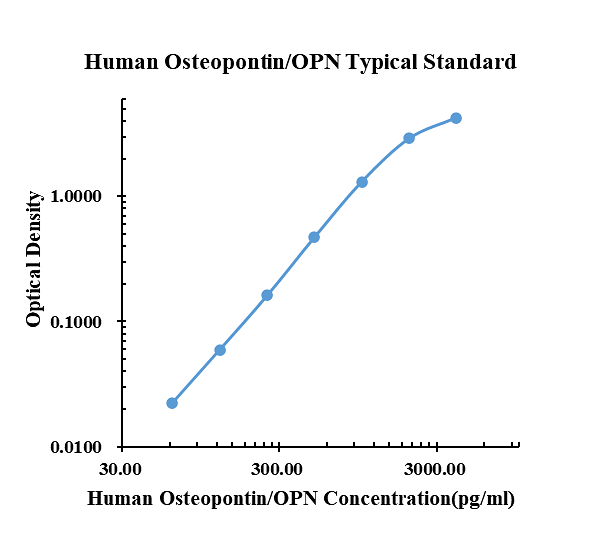Human Osteopontin/OPN DTSet enzyme-linked immunoassay kit
| Specification | 96*5 Test;96T*15 Test |
|---|---|
| Standard Curve Range | 62.50 pg/ml-4000 pg/ml |
| Standard Curve Gradient | 7 Points/3 Folds |
| Number of Incubations | 2 |
| Detectable sample | Liquid phase sample of soluble substances. For example: serum, plasma, cell culture supernatant, tissue grinding liquid, etc. |
| Sample Volume | 50 μl |
| Type | Not Ready-to-Use |
| Test Duration | 120min |

| pg/ml | O.D. | Average | Corrected | |
|---|---|---|---|---|
| 0.00 | 0.0157 | 0.0154 | 0.0156 | |
| 62.50 | 0.0384 | 0.0375 | 0.0380 | 0.0224 |
| 125.00 | 0.0766 | 0.0737 | 0.0752 | 0.0596 |
| 250.00 | 0.1785 | 0.1750 | 0.1768 | 0.1612 |
| 500.00 | 0.4878 | 0.4852 | 0.4865 | 0.4710 |
| 1000.00 | 1.3640 | 1.2860 | 1.3250 | 1.3095 |
| 2000.00 | 2.9890 | 2.8330 | 2.9110 | 2.8955 |
| 4000.00 | 4.2053 | 4.3078 | 4.2566 | 4.2410 |
Product Features
- Optimized capture and detection antibody pairings with recommended concentrations save lengthy development time
- Development protocols are provided to guide further assay optimization
- Assay can be customized to your specific needs
- Economical alternative to complete kits
Kit Content
- Capture Antibody
- Detection Antibody
- Recombinant Standard
- Streptavidin conjugated to horseradish-peroxidase (Streptavidin-HRP)
Other Reagents Required
DTSet Ancillary Reagent Kit (5 plates): containing 96 well microplates, plate sealers, substrate solution, stop solution, plate coating buffer (PBS), wash buffer, and assay buffer.
- 96 well microplates: YOUKE Life, Catalog # DSEP01. Plate Sealers: YOUKE Life, Catalog # DSSF01.
- Coating Buffer: 137 mM NaCl, 2.7 mM KCl, 8.1 mM Na2HPO4, 1.5 mM KH2PO4, pH 7.2-7.4, 0.2μm filtered . YOUKE Life, Catalog # DSCB01.
- Blocking Buffer: YOUKE Life, Catalog # DSBB01.
- Wash Buffer: 0.05% Tween® 20 in PBS, pH 7.2-7.4. YOUKE Life, Catalog # DSWB01.
- Assay Buffer: 0.5% BSA,0.05% Tween® 20,PBS Solution.YOUKE Life, Catalog # DSAB01
- Substrate Solution: Tetramethylbenzidine. YOUKE Life, Catalog # DSTS01.
- Stop Solution: 0.5mol/ml H2SO4. YOUKE Life, Catalog # DSSS01.
Product Data Sheet
Background: Osteopontin/OPN
Osteopontin (OPN), also known as bone sialoprotein (BSP), is a secreted SIBLING family protein that can be variably modified by O- and N-glycosylation, sulfation, phosphorylation, and transglutamination. OPN is widely expressed and is prominent in mineralized tissues. It inhibits bone mineralization and kidney stone formation and promotes inflammation, cell ad¬hesion, and migration. Its expression is upregulat¬ed during inflammation, obesity, atherosclerosis, cancer, and tissue damage and contributes to the pathophysiology of these conditions. The central region of OPN contains RGD and non-RGD binding sites for multiple integrins. Adjacent to the RGD motif is the sequence SLAYGLR (SVVYGLR in human) which serves as a cryptic binding site for additional integrins: it is masked in full length OPN but is exposed following OPN cleavage by multiple proteases in tumors and sites of tissue injury.

